The community of Polytechnic Heights—just plain ol’ “Poly” to you and me—began as many a community began: with no plans of community.
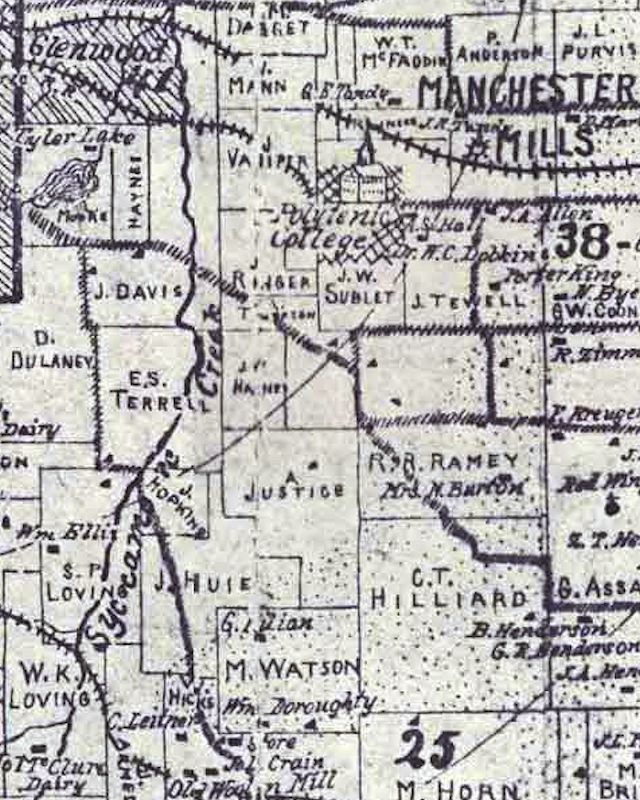 First one pioneer family settled over here in total isolation, then a second pioneer family settled over there in total isolation. For example: W. R. Loving and his brother Samuel and Samuel’s wife Elizabeth Loving from Tennessee settled on Sycamore Creek in 1849, just as the Army was establishing its Fort Worth. In fact, as a carpenter, Samuel Loving helped build the fort. An 1895 county map shows the two Loving brothers’ surveys along Sycamore Creek. Soon Benjamin P. Ayres and family, also from Tennessee, settled on the creek. Perhaps a mile of prairie and winding creek separated the Lovings and the Ayreses. (Map detail from Pete Charlton’s “1000+ Lost Antique Maps of Texas & the Southwest on DVD-ROM.”)
First one pioneer family settled over here in total isolation, then a second pioneer family settled over there in total isolation. For example: W. R. Loving and his brother Samuel and Samuel’s wife Elizabeth Loving from Tennessee settled on Sycamore Creek in 1849, just as the Army was establishing its Fort Worth. In fact, as a carpenter, Samuel Loving helped build the fort. An 1895 county map shows the two Loving brothers’ surveys along Sycamore Creek. Soon Benjamin P. Ayres and family, also from Tennessee, settled on the creek. Perhaps a mile of prairie and winding creek separated the Lovings and the Ayreses. (Map detail from Pete Charlton’s “1000+ Lost Antique Maps of Texas & the Southwest on DVD-ROM.”)
In 1853 Jack Durrett, a fiddle player from Tennessee, settled on the road between Johnson Station (in present-day Arlington) and Fort Worth. Also in 1853 Roger Tandy and his brother-in-law, Arch Hall, left Kentucky with their families and slaves. In 1855 they settled on land grants a mile east of the creek where the Lovings and the Ayreses had settled.
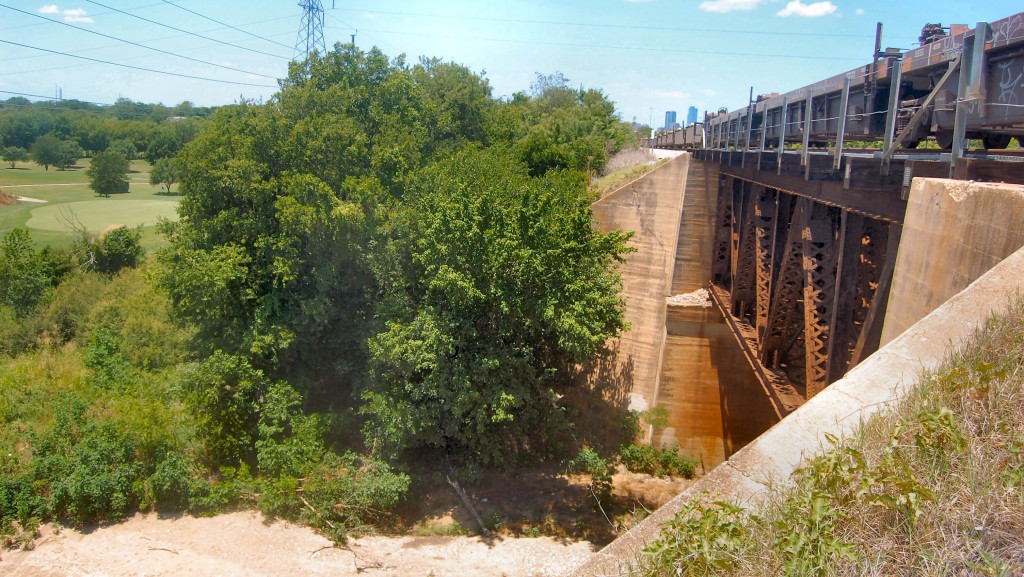
In 1876 came perhaps the nineteenth century’s greatest symbol of change: the railroad. The Texas & Pacific company laid track near early East Side settlers as the railroad advanced toward Fort Worth from Eagle Ford in Dallas County. When the T&P workers reached Sycamore Creek, there was no way across the water. So, facing a state-imposed deadline to finish the railroad, the workers improvised: Near where the creek today flows out of Sycamore golf course they hastily constructed a “crib” by stacking railroad ties in the creek bottom up to grade level and slapping down some rails. The makeshift track, Fort Worth Democrat newspaper editor B. B. Paddock declared, was “as crooked as the proverbial ram’s horn.” But the locomotive held its breath and tiptoed over Sycamore Creek and on to Fort Worth on July 19.
Now change came more rapidly for the early settlers east of Fort Worth. Even their prairie soundscape changed: Now, in addition to the howl of the wolf and the shriek of the hawk, they heard the whistle of the steam locomotive and the clatter of the cars. Soon the gaps between isolated cabins began to fill as more settlers arrived, many of them lured by Peters Colony land grants. Soon the basic infrastructure of community was needed. A church here and there. A mill. A trading post. A blacksmith. A school. Isolation yielded to cooperation.
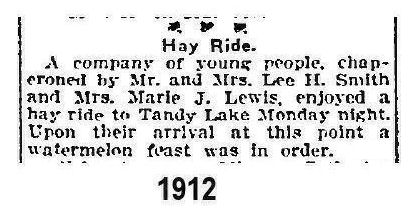 In the 1880s, just west of the present intersection of Ayers Avenue and Lancaster Avenue, Roger Tandy dammed a small tributary of Sycamore Creek and built Tandy Lake, which would be a popular recreational area into the early twentieth century. Today runoff that once fed the lake is still channeled west to Sycamore Creek.
In the 1880s, just west of the present intersection of Ayers Avenue and Lancaster Avenue, Roger Tandy dammed a small tributary of Sycamore Creek and built Tandy Lake, which would be a popular recreational area into the early twentieth century. Today runoff that once fed the lake is still channeled west to Sycamore Creek.
In 1883 a school was built near Arch Hall’s home to teach the area children and tenants of the Hall and Tandy families. In 1886 a public school was opened, taught by a graduate of Vassar no less.
Then came 1891—for the nascent community an even bigger year than 1876. The southern Methodist Episcopal Church announced plans to build a college. The college would be built on an “eminence 75 feet above Fort Worth”—the moral high ground—and two miles from the temptations of Hell’s Half Acre.
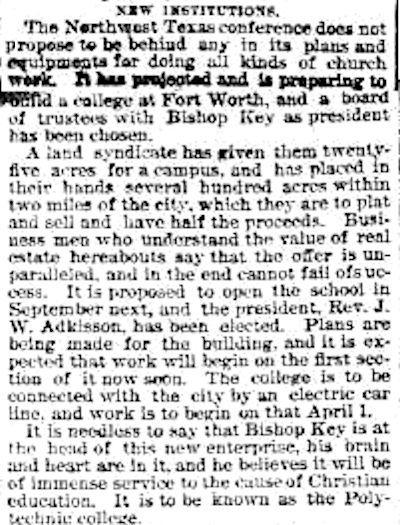 On April 20, 1891 the Fort Worth Gazette announced that a local land syndicate had donated twenty-five acres for a college campus and hundreds of acres for home development; the college would be connected with the city of Fort Worth by an electric streetcar line. The new college, to be known as “Polytechnic College,” would open in September.
On April 20, 1891 the Fort Worth Gazette announced that a local land syndicate had donated twenty-five acres for a college campus and hundreds of acres for home development; the college would be connected with the city of Fort Worth by an electric streetcar line. The new college, to be known as “Polytechnic College,” would open in September.
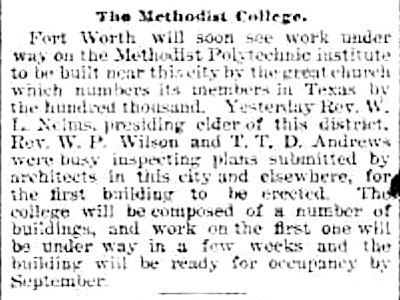 The next day the Gazette reported that Methodist officials were inspecting plans submitted by architects. Clip is from the April 21 Gazette.
The next day the Gazette reported that Methodist officials were inspecting plans submitted by architects. Clip is from the April 21 Gazette.
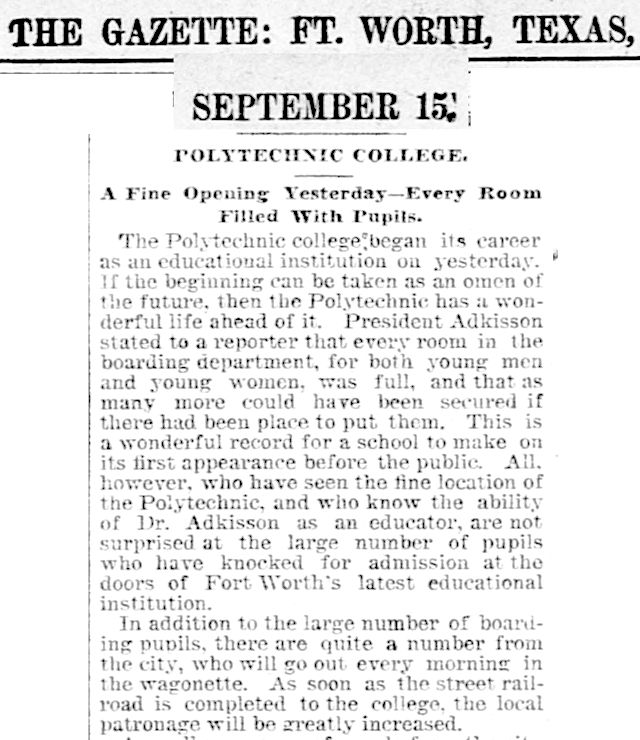 Folks didn’t dawdle in days of yore. Plans for the college were announced in April, and quicker than you can say “feasibility study,” in September the college opened. The Gazette on September 15 reported that Polytechnic College had opened the previous day.
Folks didn’t dawdle in days of yore. Plans for the college were announced in April, and quicker than you can say “feasibility study,” in September the college opened. The Gazette on September 15 reported that Polytechnic College had opened the previous day.
By 1891 the community had its second generation of leaders: George Tandy, son of Roger, along with his elder kinsmen, brothers Arch and W. D. Hall, were members of the land syndicate that had donated land for the campus.
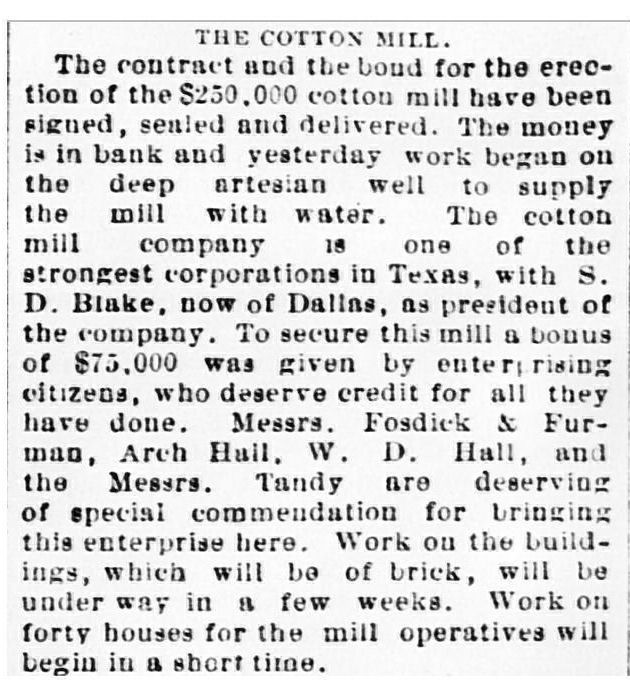 In 1890 plans had been announced for the community’s first industry: a cotton mill, to be located just north of the T&P tracks at present-day Ayers Avenue, just a half-mile from the planned college. Again the Tandy and Hall families took the lead, contributing to a $75,000 bonus to the British investors who would build the mill.
In 1890 plans had been announced for the community’s first industry: a cotton mill, to be located just north of the T&P tracks at present-day Ayers Avenue, just a half-mile from the planned college. Again the Tandy and Hall families took the lead, contributing to a $75,000 bonus to the British investors who would build the mill.
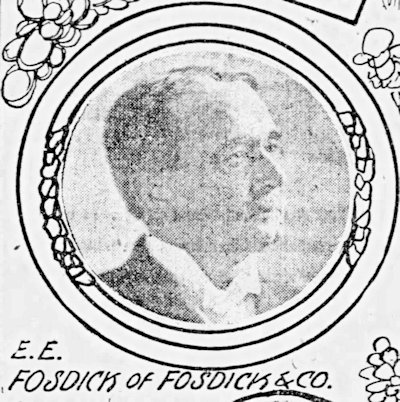 That Fosdick in the clip was Edwin E. Fosdick, who later would impound a small lake and establish a country club on the East Side. The country club failed, but the lake survives as Fosdick Lake in Oakland Park.
That Fosdick in the clip was Edwin E. Fosdick, who later would impound a small lake and establish a country club on the East Side. The country club failed, but the lake survives as Fosdick Lake in Oakland Park.
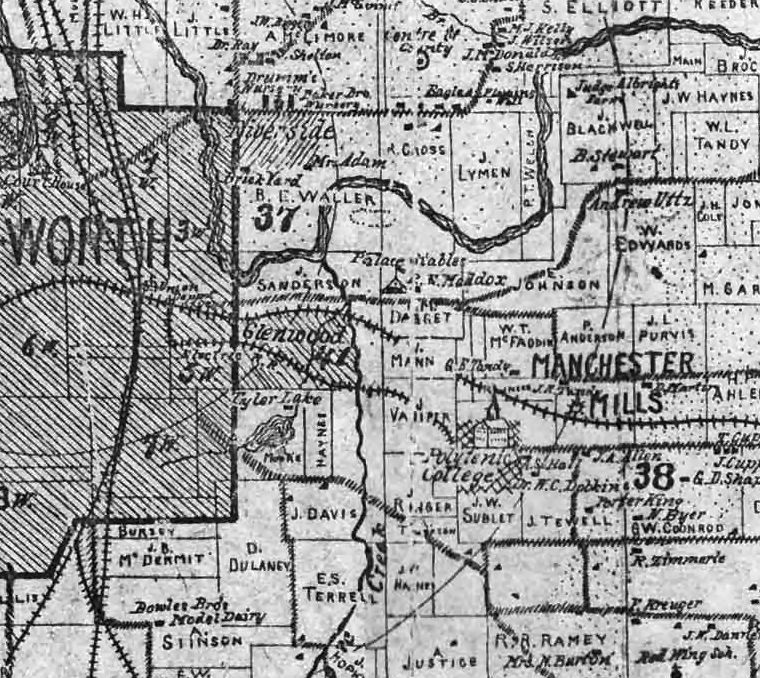
By one account of Poly history, those British investors gave their new cotton mill a name reminiscent of their motherland: Manchester Mills. (1895 Sam Street map detail from Pete Charlton’s “The Lost Antique Maps of Texas: Fort Worth & Tarrant County, Volume 2” CD.)
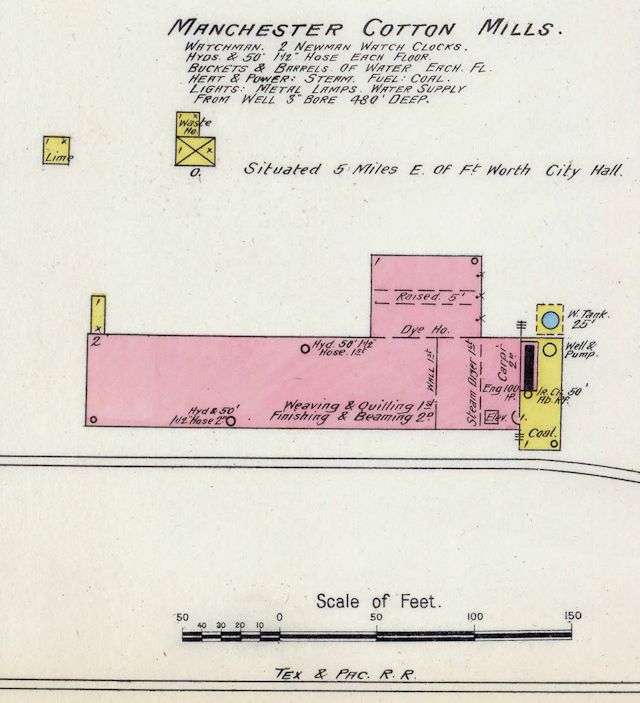 A Sanborn map of 1893 shows the Manchester cotton mill north of the T&P tracks and five miles east of Fort Worth’s city hall.
A Sanborn map of 1893 shows the Manchester cotton mill north of the T&P tracks and five miles east of Fort Worth’s city hall.
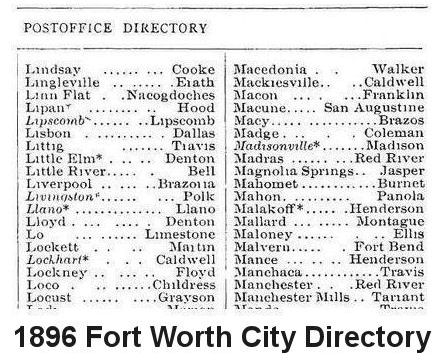
Suddenly, by 1891, the community had an industry, a college, and a name. The first post office was named “Manchester Mills.” A public school was built near the mill in 1891.
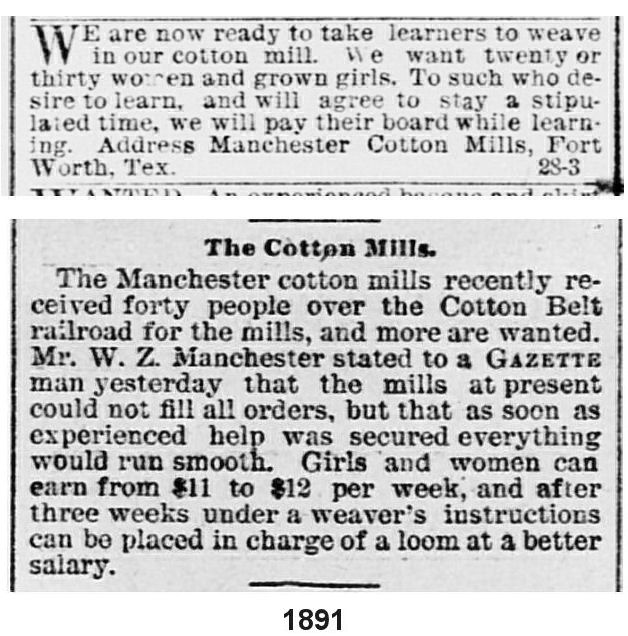
Notice that a W. Z. Manchester, a local capitalist, had a big hand in the cotton mill. Could it be he, not the city of Manchester, England, that gave Manchester Mills its name? Mr. Manchester also had a big hand in the stove foundry on the west side of Fort Worth. Regardless of how the mill got its name, the mill provided jobs for dozens of people. But the college was the bigger development in terms of prestige. Mighty Fort Worth had Fort Worth University, which had begun in 1881 as the northern Methodists’ Texas Wesleyan College. Now the southern Methodists had brought little Manchester Mills its own college: Polytechnic College.
In 1892 Reverend Columbus Asbury Evans (father of journalist Silliman Evans) and a congregation of thirty-six met in the auditorium of the college and organized Polytechnic Methodist Episcopal Church South. Ann Waggoner Fine Arts Building replaced that auditorium in 1909.
 The college prospered. By 1894 it had departments of literature, art, music, education, and business.
The college prospered. By 1894 it had departments of literature, art, music, education, and business.
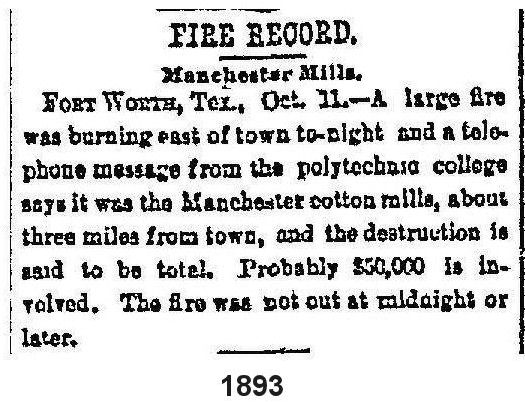
In fact, the college outlived the mill.
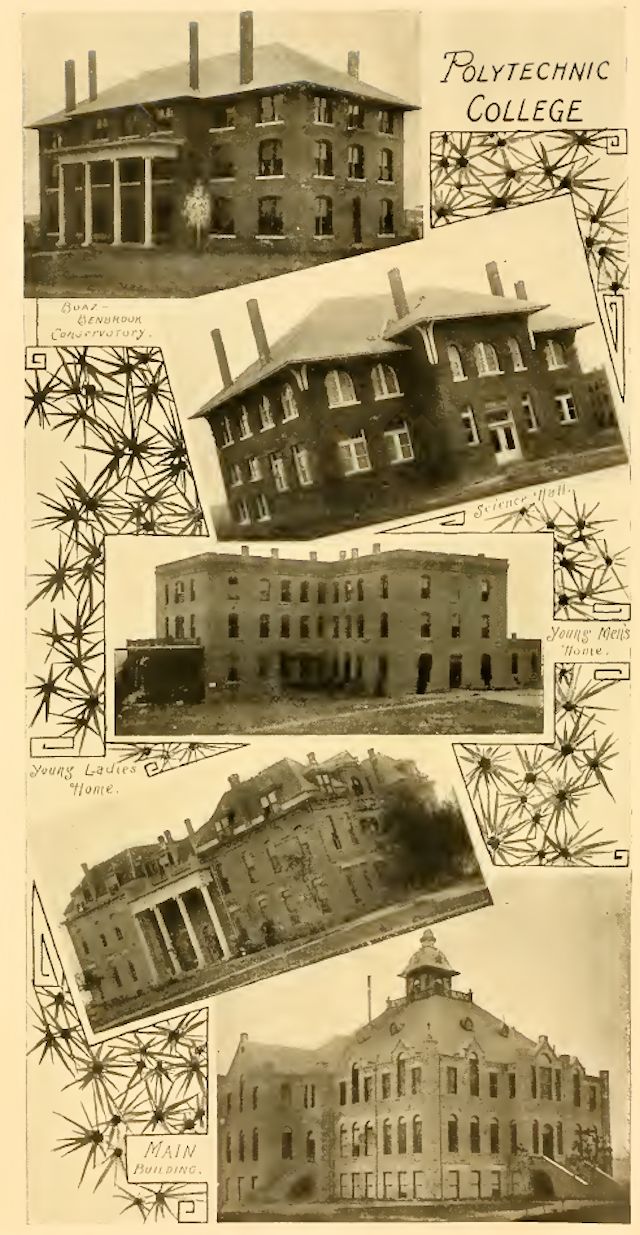 Photos from Greater Fort Worth, 1907.
Photos from Greater Fort Worth, 1907.
 The faculty, as shown in the college’s first yearbook, the 1906 Panther City Parrot (photo from Amon Carter Museum). Polytechnic College would become Texas Woman’s College in 1914, Texas Wesleyan College in 1935, and Texas Wesleyan University in 1989.
The faculty, as shown in the college’s first yearbook, the 1906 Panther City Parrot (photo from Amon Carter Museum). Polytechnic College would become Texas Woman’s College in 1914, Texas Wesleyan College in 1935, and Texas Wesleyan University in 1989.
 Texas Woman’s College placed this ad in the 1925 Poly High School yearbook.
Texas Woman’s College placed this ad in the 1925 Poly High School yearbook.
 In 1906 even the name of the community was changed, reflecting the shift of the center of the community’s universe from the cotton mill to the college: Manchester Mills officially became Polytechnic Heights.
In 1906 even the name of the community was changed, reflecting the shift of the center of the community’s universe from the cotton mill to the college: Manchester Mills officially became Polytechnic Heights.
The community that grew out of the isolated prairie and took its name—and much of its pride—from Polytechnic College was growing in the new century.
But that’s another story:






I read here, maybe a year ago about life around Vaughn Blvd. Can’t find it now. Is there any way to find it now? I grew up in South Poly in 50’s and 60’s. Do you have anything on that part of town? I believe it was in Cowtown Yoostabes maybe.
Gary, being from Poly I have written about that part of town more than any other except maybe downtown. You can navigate two ways: You can search the blog in the search box in the right-hand column for terms like “Vaughn Boulevard” (at least three posts on Vaughn, including video), “Rosedale,” etc. Or you can see posts about the East Side in the “Downtown, All Around” subcategory in the right-hand column.
I grew up on the Southwest side of town in an apartment complex that is now called Vieux Coulee (formerly Churchill Park. The apartment complexes were right next to Benbrook, and we lived in close proximity to a storage facility called U Stor. Every time we needed to get our holiday decorations or pay our storage bills, we would take the car and drive to that U Stor. It was one of my greatest childhood memories.
Is there any connection between “Texas Woman’s College” and the similarly-named institution in Denton?
Steve, I think not. But the history (name, acronym, affiliation, etc.) of some colleges and high schools, such as Fort Worth University and the high school now on that site (Tech) is so convoluted that you need to leave a trail of bread crumbs as you meander through it.
Fort Worth is my home
turf,also. Great info. Can’t wait to read more. Do you plan to do something on the old cemeteries of Fort Worth? Oakwood,the old settlers cemetary?
Thank you, Mary. I spend a lot of time in Oakwood, Pioneers Rest, the lesser-known “pocket cemeteries.” Lots more to come from our horizontal history books.
Terrific, informative post. Love it!
Thanks, Paul. Been squirreling away information on my home turf for a few years and decided to finally try to string it all together.